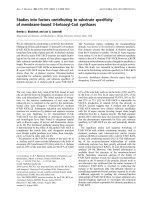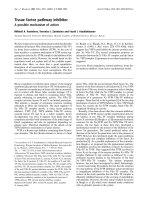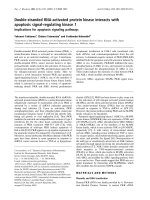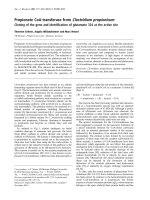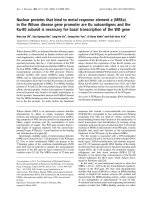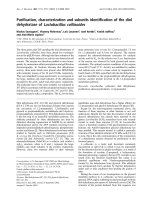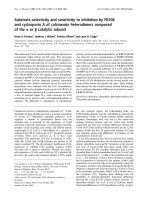Báo cáo y học: " Dendritic cell-mediated HIV-1 transmission to T cells of LAD-1 patients is impaired due to the defect in LFA-1" docx
Bạn đang xem bản rút gọn của tài liệu. Xem và tải ngay bản đầy đủ của tài liệu tại đây (420.36 KB, 9 trang )
BioMed Central
Page 1 of 9
(page number not for citation purposes)
Retrovirology
Open Access
Research
Dendritic cell-mediated HIV-1 transmission to T cells of LAD-1
patients is impaired due to the defect in LFA-1
Fedde Groot
1,2,4
, Taco W Kuijpers
3
, Ben Berkhout
1
and Esther C de Jong*
2
Address:
1
Department of Human Retrovirology, Academic Medical Centre, University of Amsterdam, Amsterdam, The Netherlands,
2
Department
of Cell Biology and Histology, Academic Medical Centre, University of Amsterdam, Amsterdam, The Netherlands,
3
Division of Pediatric
Hematology, Immunology and Infectious Diseases, Emma Children's Hospital, Academic Medical Centre, University of Amsterdam, Amsterdam,
The Netherlands and
4
Present address: The Sir William Dunn School of Pathology, University of Oxford, Oxford, United Kingdom
Email: Fedde Groot - ; Taco W Kuijpers - ; Ben Berkhout - ; Esther C de
Jong* -
* Corresponding author
Abstract
Background: Dendritic cells (DC) have been proposed to mediate sexual HIV-1 transmission by
capturing the virus in the mucosa and subsequently presenting it to CD4
+
T cells. We have
demonstrated before that DC subsets expressing higher levels of intercellular adhesion molecule-
1 (ICAM-1) are better HIV-1 transmitters. ICAM-1 binds leukocyte function-associated molecule-
1 (LFA-1) on T cells, an integrin responsible for adhesion and signaling at the immunological
synapse. To corroborate the importance of the ICAM-1— LFA-1 interaction, we performed
transmission experiments to LFA-1 negative leukocytes from Leukocyte Adhesion Deficiency type
1 (LAD-1) patients.
Results: We clearly show that DC-mediated HIV-1 transmission to LAD-1 T cells is impaired in
comparison to healthy controls. Furthermore, HIV-1 transmission to T cells from a unique LAD-1
patient with a well characterized LFA-1 activation defect was impaired as well, demonstrating that
activation of LFA-1 is crucial for efficient transmission. Decreased cell adhesion between DC and
LAD-1 T cells could also be illustrated by significantly smaller DC-T cell clusters after HIV-1
transmission.
Conclusion: By making use of LFA-1 defect cells from unique patients, this study provides more
insight into the mechanism of HIV-1 transmission by DC. This may offer new treatment options to
reduce sexual transmission of HIV-1.
Background
One of the first cell types encountered by HIV-1 during
sexual transmission are intraepithelial and submucosal
dendritic cells (DC) [1-3]. DC are professional antigen-
presenting cells that sample the environment at sites of
pathogen entry. Sentinel immature DC (iDC) develop
into mature effector DC (mDC) upon activation by micro-
organisms or inflammatory signals, and migrate to the
draining lymph nodes where they encounter and stimu-
late naïve Th cells [4,5]. HIV-1 has been proposed to make
use of this migratory process, being captured by DC and
delivered to the lymph node where the virus is transmitted
to CD4
+
T cells. In addition to this, DC can facilitate local
HIV-1 replication in mucosal T cells [6,7]. HIV-1 transmis-
Published: 01 November 2006
Retrovirology 2006, 3:75 doi:10.1186/1742-4690-3-75
Received: 04 September 2006
Accepted: 01 November 2006
This article is available from: />© 2006 Groot et al; licensee BioMed Central Ltd.
This is an Open Access article distributed under the terms of the Creative Commons Attribution License ( />),
which permits unrestricted use, distribution, and reproduction in any medium, provided the original work is properly cited.
Retrovirology 2006, 3:75 />Page 2 of 9
(page number not for citation purposes)
sion by DC takes place via cell-cell contact through an
'infectious synapse' [8,9].
We have shown before that intercellular adhesion mole-
cule-1 (ICAM-1) expression on DC is crucial for HIV-1
transmission to T cells: Monocyte-derived DC subsets that
express higher levels of ICAM-1 show higher HIV-1 trans-
mission efficiencies to T cells [8], and transmission by
both monocyte-derived DC and DC isolated from blood
can be inhibited with blocking antibodies against ICAM-
1 [8,10]. During antigen presentation, ICAM-1 expressed
by DC binds to T cells via leukocyte function-associated
molecule-1 (LFA-1). This interaction plays a key role in
the initiation of immune responses by strengthening the
adhesion between DC and T cells at the immunological
synapse [11-13]. LFA-1 is an integrin composed of the
non-covalently bound α L-subunit CD11a and β2-subu-
nit CD18 [14]. Lack of proper β2 expression due to a dele-
tion or mutation in the CD18 gene leads to Leukocyte
Adhesion Deficiency type-1 (LAD-1). Patients with this
rare recessive disorder suffer from impaired wound heal-
ing without pus formation and recurring necrotic soft tis-
sue infections. As CD11/CD18 heterodimers pair
intracellularly, LFA-1 is not expressed at the cell surface of
leukocytes from LAD-1 patients. The migration of leuko-
cytes from the bloodstream into inflamed tissue is conse-
quently hampered. In healthy individuals, stimulation of
rolling leukocytes along endothelial cell lining induces a
conformational change of CD11/CD18 heterodimers
from a low to a high ligand-binding state, bringing cells to
a halt. As expected, this adhesive process is impaired in
LAD-1 patients [15-19]. A unique variant of the LAD-1
disorder has been described (LAD-1/variant syndrome)
[20]. Cells of this patient with clinical features of a mild
LAD-1 disorder do express LFA-1, but cellular activation
does not result in activation of LFA-1, i.e. the 'inside-out
signaling' that is necessary for increased ICAM-1 binding
is impaired [12,20-22].
To further corroborate the importance of LFA-1 in HIV-1
transmission, we made use of T cells from LAD-1 patients.
We found that DC-mediated HIV-1 transmission to LFA-1
negative T cells is impaired in comparison to healthy con-
trols. Furthermore, HIV-1 transmission to T cells isolated
from the unique LAD-1/variant patient is impaired too,
meaning that not only recognition of ICAM-1 but also
high-activity binding is important for efficient transmis-
sion. Finally, we show that one day after HIV-1 transmis-
sion, DC-T cell clusters of LAD-1 and LAD-1/variant cells
are significantly smaller than control clusters, which is
illustrative for the reduced cell-cell adhesion in LAD-1
patients. By making use of cells isolated from unique
patients, this study provides more insight into DC-medi-
ated HIV-1 transmission, which may offer new options to
inhibit HIV-1 transmission.
Results
DC-mediated transmission to LAD-1 T cells is impaired
To investigate the importance of the ICAM-1— LFA-1
interaction in DC-mediated HIV-1 transmission, we per-
formed transmission experiments with DC obtained from
healthy donors and peripheral blood leukocytes (PBL)
from LAD-1 patients or healthy controls. We isolated leu-
kocytes from three different LAD-1 patients, whose char-
acteristics are given in Table 1. To confirm the negative
LFA-1 status of LAD-1 leukocytes, we performed FACS
analysis on CD11a and CD18, of which one representa-
tive patient and control are depicted in Fig. 1, upper two
panels. We further determined by FACS that the expres-
sion of CD4 and CXCR4 was comparable to healthy con-
trols (results not shown). In order to test the transmission
efficiency to LAD-1 T cells, we used DC stimulated by poly
(I:C) since this subset expresses the highest level of ICAM-
1 and is the most efficient HIV-1 transmitter [8].
We incubated the DC with HIV-1 for 2 hr, followed by
washing steps to remove unbound virus. After addition of
LAD-1 or control PBL, we determined the transmission
efficiency by measuring the accumulation of HIV-1 capsid
Table 1: Characteristics of LAD patients
Gender/age CD11a/CD18 expression (MFI) % LFA-1 expression Details
LAD-1 #1 Male, 8 years 4/8 <1% of normal Late detachment of umbilical cord, recurrent infections,
BM transplantation planned.
LAD-1 #2 Male, 15 years 4/8 5% of normal Recurrent infections, no chemotaxis/adhesion of
granulocytes. Received granulocyte transfusions, no BM
donor available.
LAD-1 #3 Female, 3 years 4/7 n.d. Mild symptoms, ready for BM transplantation.
LAD-1 variant Male, 12 years 104/199 normal Late detachment of umbilical cord, mild nonpussing
inflammatory responses, necrotic of nature (20).
Granulocyte transfusions for life-threatening
pneumonia. Recently BM transplanted.
Expression of CD11a/CD18 on leukocytes was determined by FACS before addition to DC.
MFI: mean fluorescence intensity. n.d.: not determined. BM: bone marrow
Retrovirology 2006, 3:75 />Page 3 of 9
(page number not for citation purposes)
protein p24 (CA-p24) in T cells by FACS 1–3 days later. To
prevent subsequent rounds of HIV-1 replication after
transmission in this single-cycle transmission assay, we
added an inhibitor of the viral protease (saquinavir,
[23,24]). To distinguish virus transmitted to T cells from
HIV in DC, we co-stained with CD3 and DC-SIGN. DC
and T cells tend to cluster, which would hamper an accu-
rate estimation of transmission efficiency by FACS. We
therefore added EDTA to our FACS buffer to reduce the
amount of cell clustering. Indeed, the majority (95%) of
the CD3 positive cells was negative for DC-SIGN, showing
that only a few DC were attached to T cells during the
FACS analysis (Fig. 2A). In uninfected controls of LAD-1
and healthy PBL only background percentages of CA-p24
positive T cells were scored (0.06%, Fig. 2B). Addition of
HIV-1 resulted in an increase in CA-p24 positive T cells
when using PBL from healthy controls (1.09%, Fig. 2C),
whereas only a slight increase was observed in PBL from
LAD-1 donors (0.14%, Fig. 2D). The intracellular CA-p24
levels reached a maximum two days after DC-mediated
HIV-1 transmission for both control and LAD-1 PBL,
which is depicted in Fig. 2E for one representative control
and LAD-1 patient. On average, DC-mediated HIV-1
transmission to control T cells was nine times more effi-
cient (Fig. 2F, n = 3).
HIV-1 replication in LFA-1 negative T cells after DC-
mediated transmission is delayed
In addition to quantification of the transmission effi-
ciency in a single-cycle transmission assay (Fig. 2), we fol-
lowed viral replication after transmission (Fig. 3). In this
spreading infection assay, we did not add saquinavir to
allow cell-cell spread of newly produced virus. The repli-
cation of HIV-1 after transmission to LAD-1 PBL is
delayed with 1–2 days in comparison to healthy controls
(Fig. 2), which reflects the lower transmission efficiency of
figure 2. Since CA-p24 levels eventually reach a similar
plateau, we conclude that LAD-1 cells are susceptible to
HIV-1, but that the transmission is taking place at a lower
efficiency.
Activation of LFA-1 is crucial for efficient HIV-1
transmission
In order to efficiently bind ICAM-1, LFA-1 needs to be
activated. Cellular activation by chemokines from
endothelial cells or by TCR/CD3 cross-linking results in a
conformational change of LFA-1 from a low to a high lig-
and-binding state [12,21,25]. We questioned whether
LFA-1 expression by T cells is sufficient for efficient HIV-1
transmission by DC, or that additional activation of LFA-
1 is necessary. To investigate this, we used cells from a
unique patient with mild LAD-1 symptoms (LAD-1/vari-
ant). The leukocytes from this patient express LFA-1 (Fig.
1 and Table 1), but the integrin cannot be induced into an
active conformation [20]. In comparison to the experi-
ments with LFA-1 negative cells, we obtained similar
results: HIV-1 transmission to LAD-1/variant T cells was
impaired in the single-cycle assay (Fig. 4A) and replication
after transmission was delayed with 2 days (Fig. 4B). This
demonstrates that LFA-1 has to be activated to a high lig-
and-binding state in order to mediate HIV-1 transmission.
As an additional control, we infected LAD-1/variant PBL
with HIV-1 in the absence of DC (Fig 4C). HIV-1 replica-
tion in CD3/CD28 stimulated PBL from the LAD-1/vari-
ant patient was comparable to healthy controls, showing
that not replication but efficient transmission by DC
depends on LFA-1 activation.
Phenotype of LAD-1 and control PBLFigure 1
Phenotype of LAD-1 and control PBL. Representative
FACS staining for CD11a (LFA-1) and CD18 of PBL from
one healthy donor (upper panel), a LAD-1 donor (# 1 from
Table 1) (middle panel) and a unique patient with a LFA-1
activation defect (LAD-1/variant) (lower panel). The open
histograms represent the isotype controls. The mean fluo-
rescence intensity (MFI) is indicated.
104
CD11a
199
CD18
CD11a
CD18
CD11a
CD18
4
8
137 361
control
LAD-1
variant
LAD-1
Retrovirology 2006, 3:75 />Page 4 of 9
(page number not for citation purposes)
DC-mediated HIV-1 transmission to LFA-1 negative T cells is impairedFigure 2
DC-mediated HIV-1 transmission to LFA-1 negative T cells is impaired. DC were incubated with HIV-1, followed by
washing to remove unbound virus. Subsequently, LAD-1 or control PBL were added to allow transmission of HIV-1. To pre-
vent production of new virions, the cells were cultured in the presence of SQV (single-cycle transmission assay). 2 days after
transmission, PBL were harvested and stained for CD3, DC-SIGN and intracellular CA-p24 to determine the transmission effi-
ciency. (A) CD3 and DC-SIGN staining. (B) CA-p24
+
CD3
+
T cells of an uninfected sample. (C) and (D) Representative FACS
staining of a healthy control and a LAD-1 patient, respectively. The percentage CA-p24
+
CD3
+
cells is indicated. (E) Kinetics of
intracellular CA-p24 levels for a representative healthy and LAD-1 donor (n = 1). Error bars represent SD (F) Summary of
HIV-1 transmission to T cells of healthy controls (n = 3) and LAD-1 patients (n = 3), two days post transmission. Error bars
represent SEM. *P < 0.05, **P < 0.01, ***P < 0.001. One DC donor was used for all transmissions, to reduce variation.
CD3
CD3
DC-SIGN
CD3CD3
CA-p24
CA-p24
CA-p24
0.06%
0.14%
1.09%
A
C
B
D
E
0
0.2
0.4
0.6
0.8
1
control
(n=3)
LAD-1
(n=3)
% CA-p24+ T cells
***
0
0.2
0.4
0.6
0.8
1
1.2
control
(n=1)
LAD-1
(n=1)
% CA-p24 T cells
24 hr
48 hr
72 hr
F
**
*
*
Retrovirology 2006, 3:75 />Page 5 of 9
(page number not for citation purposes)
LAD-1 and LAD-1/variant T cells form smaller clusters with
DC
DC attract T cells and form large clusters in vivo and in
vitro, a process that is dependent on cell-cell adhesion
[26,27]. We studied the clusters of DC and leukocytes 24
hr after DC-mediated HIV-1 transmission. The cluster size
of DC with T cells from healthy individuals was clearly
larger than the clusters with T cells from LAD-1 and LAD-
1/variant T cells, as is shown in the photographs (Fig 5A).
Quantitative determination of the amount and diameter
of clusters showed that although the number of clusters
was only slightly reduced (30, 26 and 25 clusters on aver-
age for control, LAD-1 and LAD-1/variant respectively),
the mean cluster diameter of control cells was signifi-
cantly larger (9.1 versus 5.6 and 6.2 in arbitrary units for
LAD-1 and the variant respectively; p < 0.001 and
<0.002). We subsequently grouped the clusters according
to diameter (Fig. 5B), and clearly demonstrate that their
actual number is not reduced for the LAD-1 and LAD-1/
variant T cells, but that they are significantly smaller in
size.
Discussion
In the present study, we demonstrate the role of LFA-1 in
HIV-1 transmission by DC. Previously we have shown
that ICAM-1 expression on both monocyte-derived DC
and DC from blood is critical for HIV-1 transmission
[8,10]. In accordance with this, we now show that DC-
mediated transmission to LFA-1-negative T cells from
LAD-1 patients is severely impaired. Normally, LFA-1 is
activated by different kinds of stimuli, and binding to
ICAM-1 is subsequently up-regulated (inside-out signal-
ing) [12,13,21,28]. Currently, it is assumed that activation
of LFA-1 may be regulated via changes in affinity (active
conformation), avidity (clustering) or both [22,29-33].
The fact that transmission to T cells of a unique patient
(LAD-1/variant syndrome) [20], with an inside-out sign-
aling deficient LFA-1, was impaired as well, demonstrates
for the first time that LFA-1 activation is crucial for DC-
Activation of LFA-1 is crucial for efficient HIV-1 transmissionFigure 4
Activation of LFA-1 is crucial for efficient HIV-1
transmission. (A) Single-cycle transmission assay. Two days
after DC-mediated transmission in the presence of SQV, PBL
were harvested and stained for CD3, DC-SIGN and intracel-
lular CA-p24 to determine the percentage of HIV-1 positive
T cells. Experiments were performed twice with cells from
the same patient isolated on two separate occasions. Cells of
two different healthy controls were used. Error bars repre-
sent SD. *P < 0.02. (B) Viral replication in T cells after DC-
mediated transmission to healthy and LAD-1/variant PBL was
followed by CA-p24 ELISA of the supernatant. (C) LAD-1/
variant PBL or control cells were stimulated with anti-CD3/
CD28 antibodies and were infected with HIV-1. Viral replica-
tion was followed by CA-p24 ELISA.
P=0.016
A
B
C
0
0.2
0.4
0.6
control LAD-1/variant
% CA-p24+ Tcells
1
10
100
1000
0123456789
days
CA-p24 (ng/ml)
control
LAD-1/variant
*
0.1
1
10
100
1000
01234567
days post transmission
CA-p24 (ng/ml)
control
LAD-
1/variant
HIV-1 replication in LFA-1 negative T cells after DC-medi-ated transmission is delayedFigure 3
HIV-1 replication in LFA-1 negative T cells after DC-
mediated transmission is delayed. After DC-HIV incu-
bation and washing, LAD-1 and control PBL were added.
Viral replication was followed by measuring CA-p24 produc-
tion in the supernatant by ELISA. We used cells of three
LAD-1 and three healthy donors (n = 3). Error bars repre-
sent SEM.
0.1
1
10
100
1000
01234567
days post transmission
CA-p24 (ng/ml)
control
LAD-1
Retrovirology 2006, 3:75 />Page 6 of 9
(page number not for citation purposes)
LAD-1 and LAD-1/variant T cells form smaller clusters with DCFigure 5
LAD-1 and LAD-1/variant T cells form smaller clusters with DC. (A) Representative light microscopic images of DC-
T cell clusters with healthy, LAD-1 and LAD-1/variant T cells, one day after HIV-1 transmission. (B) The number and diameter
of DC-T cell clusters of cells from LAD-1 patients (n = 3), the LAD-1/variant patient (n = 1), and healthy controls (n = 3) were
determined one day after HIV-1 transmission, and the clusters were subsequently grouped according to size. Error bars repre-
sent standard deviations. *P < 0.05, **P < 0.01, compared to corresponding cluster group from 'control'.
control LAD-1 LAD-1/variant
cluster diameter
(arbitr. units)
A
B
4-6
7-9
10-12
>12
0
5
10
15
20
25
control LAD-1 LAD-1/variant
amount DC-T cell clusters
(n=3) (n=3) (n=1)
*
*
**
Retrovirology 2006, 3:75 />Page 7 of 9
(page number not for citation purposes)
mediated HIV-1 transmission. Although LFA-1 of this
patient is able to recognize its ligand, no high avidity/
affinity binding to ICAM-1 is taking place. Since there is
no strong binding to ICAM-1, signaling through LFA-1
into the T cell (outside-in signaling) is probably not tak-
ing place either. In healthy individuals, signaling through
LFA-1 after ICAM-1 binding leads to actin polymerization
and remodeling, which is important for enhanced cell
adhesion [34]. Impaired cell adhesion in LAD-1 (and var-
iant) patients can also be illustrated by the significantly
smaller clusters of DC with T cells (Fig. 5). A smaller
number of T cells that is tightly attached to DC will result
in a decrease of the window of opportunity for HIV-1
transmission. Furthermore, it is likely that the creation of
an 'infectious synapse' is disturbed in LAD-1 and LAD-1/
variant patients. Others have shown that DC-SIGN is an
important component of the infectious synapse [9,35].
Our results strongly indicate that LFA-1 is also important
for infectious synapse formation, possibly through
cytoskeletal rearrangements that are induced by ICAM-1
binding.
The infectivity and subsequent replication of HIV-1 in T
cells can be influenced by T cell activation and prolifera-
tion. Due to the young age of the patients and severity of
the disease, no more cells could be obtained from these
patients to perform a separate mixed lymphocyte reaction
(MLR). However, we found no lower cellular proliferation
of LAD-1 and LAD-1/variant T cells after co-culture with
DC during FACS analysis, nor did we find higher percent-
ages of dead cells. In addition, the leukocytes of the LAD-
1/variant patient have been shown to proliferate nor-
mally, and have normal calcium influx, actin metabolism
and protein kinase activity [20]. Another factor influenc-
ing HIV-1 infectivity is the incorporation of host ICAM-1
in budding virions and expression of LFA-1 on target cells
[36-40]. To critically test this hypothesis, we performed
transmission experiments with HIV-1 produced both in
C33A cells and in PM1 T cells. C33A cells do not express
ICAM-1 (or LFA-1), yielding virions without ICAM-1.
With both virus stocks, we found impaired DC-mediated
transmission to T cells of LAD-1/variant and LAD-1
patients, ruling out that the virus-producer cell is of influ-
ence. This observation is in concordance with our previ-
ous work [8] and the work of Bounou and co-workers,
who showed that in DC-mediated HIV-1 transmission,
virion-associated ICAM-1 is of no influence [41]. Further-
more, we have shown that LAD-1/variant and control T
cells are equally susceptible to HIV-1 in the absence of
DC, demonstrating that the DC-mediated transmission
itself is impaired, instead of the ability of HIV-1 to infect
these cells.
The importance of the ICAM-1— LFA-1 interaction for
DC-T cell contact and HIV-1 transmission suggests a new
therapeutic target for the development of transmission-
blockers. Interestingly, the fungal metabolite lovastatin,
which belongs to the statin compounds used in the treat-
ment of hypercholesterolemia, was shown to bind LFA-1
and inhibit the interaction with ICAM-1 [42]. Further-
more, lovastatin was recently shown to block entry of
ICAM-1-containing HIV-1 virion particles into T cells
[43]. We therefore tested whether lovastatin could block
DC-mediated HIV-1 transmission. Although we measured
a significant decrease in HIV-1 transmission, inhibition
was due to toxicity of the compound at the micromolar
range that is required for blocking the ICAM-1— LFA-1
interaction (results not shown). Given the importance of
LFA-1 in HIV-1 transmission by DC, future research
should focus on the development of less toxic derivatives
or other small molecule inhibitors of the ICAM-1— LFA-
1 interaction [44,45]. Now that there is proof that com-
pounds can be generated that potently inhibit and target
integrins like LFA-1 [46] the use of such selective oral
compounds may prove very useful in preventing or treat-
ing various diseases. With respect to HIV-1 transmission,
these compounds can be used in combination with other
drugs in a microbicide mixture that will help slowing
down the ongoing HIV-1 pandemic.
Materials and methods
Generation of monocyte-derived dendritic cells
Peripheral blood mononuclear cells (PBMC) were iso-
lated from blood of healthy donors by density centrifuga-
tion on Lymphoprep (Nycomed, Torshov, Norway).
Subsequently, PBMC were layered on a Percoll gradient
(Pharmacia, Uppsala, Sweden) with three density layers
(1.076, 1.059, and 1.045 g/ml). The light fraction with
predominantly monocytes was collected, washed, and
seeded in 24-well or 6-well culture plates (Costar, Cam-
bridge, MA, USA) at a density of 5 × 10
5
cells or 2,5 × 10
6
per well, respectively. After 60 min at 37°C, nonadherent
cells were removed, and adherent cells were cultured to
obtain immature DC in Iscove's modified Dulbecco's
medium (IMDM; Life Technologies Ltd., Paisley, United
Kingdom) with gentamicin (86 μg/ml; Duchefa, Haarlem,
The Netherlands) and 10% fetal clone serum (HyClone,
Logan, UT, USA) and supplemented with GM-CSF (500
U/ml; Schering-Plough, Uden, The Netherlands) and IL-4
(250 U/ml; Strathmann Biotec AG, Hannover, Germany).
At day 3, the culture medium with supplements was
refreshed. At day 6, maturation was induced by culturing
the cells with poly (I:C) (20 μg/ml; Sigma-Aldrich, St.
Louis, MO, USA). After two days, mature CD14
-
CD1b
+
CD83
+
DC were obtained. All subsequent tests were per-
formed after harvesting and extensive washing of the cells
to remove all factors. Mature DC were analysed for the
expression of cell surface molecules by FACS. Mouse anti-
human mAbs were used against the following molecules:
CD14 (BD Biosciences, San Jose, CA, USA), CD1b (Dia-
Retrovirology 2006, 3:75 />Page 8 of 9
(page number not for citation purposes)
clone, Besançon, France), CD83 (Immunotech, Marseille,
France) and ICAM-1 (CD54) (Pelicluster, Sanquin,
Amsterdam, The Netherlands). All mAb incubations were
followed by incubation with FITC-conjugated goat F(ab')
2
anti-mouse IgG and IgM (Jackson ImmunoResearch Lab-
oratories, West Grove, PA, USA). Samples were analysed
on a FACScan (BD Biosciences).
Peripheral Blood Leukocytes
Peripheral Blood Leukocytes (PBL) were isolated by layer-
ing PBMC from healthy donors and LAD-1 patients on a
Percoll gradient. The heavy fraction with predominantly
PBL was collected and stored at -150°C. PBL were cul-
tured in IMDM with 10% FCS, gentamycin, 10 U/ml IL-2
(Cetus, Emeryville, CA, USA) and Staphylococcus entero-
toxin B (SEB; Sigma-Aldrich; final concentration, 10 pg/
ml). Mouse mAb to human CD28 (CLB-CD28/1) and
human CD3 (CLB-T3/4E-1XE) were obtained from San-
quin (Amsterdam, The Netherlands).
Virus stocks
C33A cervix carcinoma cells or PM1 T cells were trans-
fected using calcium phosphate or electroporation respec-
tively with 5 μg of the molecular clone of HIV-1 LAI. Since
any of the patients could bear one or two mutant alleles
for the CCR5 co-receptor, resulting is decreased suscepti-
bility to CCR5-using HIV-1, we chose to use CXCR4-using
HIV-1 LAI. The virus containing supernatant was har-
vested 3 to 5 days post transfection, filtered and stored at
-80°C. The concentration of virus was determined by CA-
p24 ELISA. C33A and PM1 cells were maintained in Dul-
becco's Modified Eagle's Medium (DMEM) or Roswell
Park Memorial Institute (RPMI) medium 1640 (Life Tech-
nologies) respectively, both supplemented with 10% FCS,
2 mM sodium pyruvate, 10 mM HEPES, 2 mM L-
glutamine, penicillin (100 U/ml) (Sigma-Aldrich) and
streptomycin (100 μg/ml) (Invitrogen, Breda, The Nether-
lands).
HIV transmission assay and CA-p24 measurement
Fully matured DC were incubated in a 96-well-plate (40–
50 × 10
3
DC/50 μl/well) with PM1 produced virus (10 ng
CA-p24/well) or C33A produced virus (20 ng) for 2 hr at
37°C. The DC were washed with PBS after centrifugation
at 400 × g to remove unbound virus. Washing was
repeated, followed by addition of 50 × 10
3
PBL. Prior to
addition to DC the PBL were analyzed by FACS with the
following mouse anti-human antibodies: FITC-labeled
CD11a (Pelicluster, Sanquin), APC-labeled CD4 (BD Bio-
sciences) and PE-labeled CXCR4 (BD Biosciences). CD18
(Pelicluster, Sanquin) incubation was followed by incu-
bation with FITC-conjugated goat F(ab')
2
anti-mouse IgG
and IgM (Jackson ImmunoResearch Laboratories). Viral
replication after transmission was followed by measuring
CA-p24 in the culture supernatant by ELISA. To determine
intracellular CA-p24 in the single-cycle transmission
assay, saquinavir (Roche, London, United Kingdom at 0.2
μM) was added to prevent cell-to-cell spread of newly pro-
duced virions. After 48 hr, the cells were harvested and
stained with FITC-labeled CD3 (BD Biosciences) and
APC-labeled DC-SIGN (R7D Systems, MN, USA), fol-
lowed by fixation with 4% PFA and washing with washing
buffer (PBS with 2 mM EDTA and 0.5% BSA). Fixated cells
were then washed with perm/wash buffer (BD Bio-
sciences), and incubated with PE-labelled CA-p24 (KC57-
RD1, Coulter, Hialeah, FL, USA) followed by washing
with successively perm/wash- and washing buffer. Cells
were then analysed by FACS.
Statistical analysis
Data were analysed for statistical significance (GraphPad
InStat, Inc, San Diego, CA, USA) using ANOVA. A p value
<0.05 was considered to be significant.
Abbreviations
ICAM-1: intercellular adhesion molecule-1; LAD-1: Leu-
kocyte Adhesion Deficiency type 1; LFA-1: leukocyte func-
tion-associated molecule-1
Acknowledgements
This research has been funded by grant 7008 from Aids Fonds Netherlands.
We thank Rogier Sanders for critical reading of the manuscript.
References
1. Choi YK, Whelton KM, Mlechick B, Murphey-Corb MA, Reinhart TA:
Productive infection of dendritic cells by simian immunode-
ficiency virus in macaque intestinal tissues. J Pathol 2003,
201:616-628.
2. Hu J, Gardner MB, Miller CJ: Simian immunodeficiency virus
rapidly penetrates the cervicovaginal mucosa after intravag-
inal inoculation and infects intraepithelial dendritic cells. J
Virol 2000, 74:6087-6095.
3. Spira AI, Marx PA, Patterson BK, Mahoney J, Koup RA, Wolinsky SM,
Ho DD: Cellular targets of infection and route of viral dissem-
ination after an intravaginal inoculation of simian immuno-
deficiency virus into rhesus macaques. J Exp Med 1996,
183:215-225.
4. Banchereau J, Steinman RM: Dendritic cells and the control of
immunity. Nature 1998, 392:245-252.
5. Banchereau J, Briere F, Caux C, Davoust J, Lebecque S, Liu YJ, Pulen-
dran B, Palucka K: Immunobiology of dendritic cells. Annu Rev
Immunol 2000, 18:767-811.
6. Rowland-Jones SL: HIV: The deadly passenger in dendritic cells.
Curr Biol 1999, 9:R248-R250.
7. Pope M, Haase AT: Transmission, acute HIV-1 infection and
the quest for strategies to prevent infection. Nat Med 2003,
9:847-852.
8. Sanders RW, de Jong EC, Baldwin CE, Schuitemaker JH, Kapsenberg
ML, Berkhout B: Differential transmission of human immuno-
deficiency virus type 1 by distinct subsets of effector den-
dritic cells. J Virol 2002, 76:7812-7821.
9. McDonald D, Wu L, Bohks SM, KewalRamani VN, Unutmaz D, Hope
TJ: Recruitment of HIV and its receptors to dendritic cell-T
cell junctions. Science 2003, 300:1295-1297.
10. Groot F, van Capel TM, Kapsenberg ML, Berkhout B, de Jong EC:
Opposing roles of blood myeloid and plasmacytoid dendritic
cells in HIV-1 infection of T cells: transmission facilitation
versus replication inhibition. Blood 2006, 108:1957-1964.
11. Bromley SK, Burack WR, Johnson KG, Somersalo K, Sims TN, Sumen
C, Davis MM, Shaw AS, Allen PM, Dustin ML:
The immunological
synapse. Annu Rev Immunol 2001, 19:375-396.
Publish with BioMed Central and every
scientist can read your work free of charge
"BioMed Central will be the most significant development for
disseminating the results of biomedical research in our lifetime."
Sir Paul Nurse, Cancer Research UK
Your research papers will be:
available free of charge to the entire biomedical community
peer reviewed and published immediately upon acceptance
cited in PubMed and archived on PubMed Central
yours — you keep the copyright
Submit your manuscript here:
/>BioMedcentral
Retrovirology 2006, 3:75 />Page 9 of 9
(page number not for citation purposes)
12. Dustin ML, Springer TA: T-cell receptor cross-linking tran-
siently stimulates adhesiveness through LFA-1. Nature 1989,
341:619-624.
13. van Kooyk Y, Kemenade W, Weder P, Kuijpers TW, Figdor CG:
Enhancement of LFA-1-mediated cell adhesion by triggering
through CD2 or CD3 on T lymphocytes. Nature 1989,
342:811-813.
14. Springer TA: Adhesion receptors of the immune system.
Nature 1990, 346:425-434.
15. Hogg N, Bates PA: Genetic analysis of integrin function in man:
LAD-1 and other syndromes. Matrix Biol 2000, 19:211-222.
16. Anderson DC, Springer TA: Leukocyte adhesion deficiency: an
inherited defect in the Mac-1, LFA-1, and p150,95 glycopro-
teins. Annu Rev Med 1987, 38:175-194.
17. Springer TA: Traffic signals for lymphocyte recirculation and
leukocyte emigration: the multistep paradigm. Cell 1994,
76:301-314.
18. Lawrence MB, Springer TA: Leukocytes roll on a selectin at
physiologic flow rates: distinction from and prerequisite for
adhesion through integrins. Cell 1991, 65:859-873.
19. von Andrian UH, Chambers JD, McEvoy LM, Bargatze RF, Arfors KE,
Butcher EC: Two-step model of leukocyte-endothelial cell
interaction in inflammation: distinct roles for LECAM-1 and
the leukocyte beta 2 integrins in vivo. Proc Natl Acad Sci U S A
1991, 88:7538-7542.
20. Kuijpers TW, van Lier RA, Hamann D, de Boer M, Thung LY, Ween-
ing RS, Verhoeven AJ, Roos D: Leukocyte adhesion deficiency
type 1 (LAD-1)/variant. A novel immunodeficiency syn-
drome characterized by dysfunctional beta2 integrins. J Clin
Invest 1997, 100:1725-1733.
21. Diamond MS, Springer TA: The dynamic regulation of integrin
adhesiveness. Curr Biol 1994, 4:506-517.
22. van Kooyk Y, Figdor CG: Avidity regulation of integrins: the
driving force in leukocyte adhesion. Curr Opin Cell Biol
2000,
12:542-547.
23. Wlodawer A, Vondrasek J: Inhibitors of HIV-1 protease: a major
success of structure-assisted drug design. Annu Rev Biophys Bio-
mol Struct 1998, 27:249-284.
24. Ganesh L, Leung K, Lore K, Levin R, Panet A, Schwartz O, Koup RA,
Nabel GJ: Infection of specific dendritic cells by CCR5-tropic
human immunodeficiency virus type 1 promotes cell-medi-
ated transmission of virus resistant to broadly neutralizing
antibodies. J Virol 2004, 78:11980-11987.
25. Shamri R, Grabovsky V, Gauguet JM, Feigelson S, Manevich E, Kolanus
W, Robinson MK, Staunton DE, von Andrian UH, Alon R: Lym-
phocyte arrest requires instantaneous induction of an
extended LFA-1 conformation mediated by endothelium-
bound chemokines. Nat Immunol 2005, 6:497-506.
26. Ingulli E, Mondino A, Khoruts A, Jenkins MK: In vivo detection of
dendritic cell antigen presentation to CD4(+) T cells. J Exp
Med 1997, 185:2133-2141.
27. Steinman RM: The dendritic cell system and its role in immu-
nogenicity. Annu Rev Immunol 1991, 9:271-296.
28. Atarashi K, Hirata T, Matsumoto M, Kanemitsu N, Miyasaka M: Roll-
ing of Th1 cells via P-selectin glycoprotein ligand-1 stimu-
lates LFA-1-mediated cell binding to ICAM-1. J Immunol 2005,
174:1424-1432.
29. Carman CV, Springer TA: Integrin avidity regulation: are
changes in affinity and conformation underemphasized? Curr
Opin Cell Biol 2003, 15:547-556.
30. van Kooyk Y, van Vliet SJ, Figdor CG: The actin cytoskeleton reg-
ulates LFA-1 ligand binding through avidity rather than affin-
ity changes. J Biol Chem 1999, 274:26869-26877.
31. Hogg N, Henderson R, Leitinger B, McDowall A, Porter J, Stanley P:
Mechanisms contributing to the activity of integrins on leu-
kocytes. Immunol Rev 2002, 186:164-171.
32. Constantin G, Majeed M, Giagulli C, Piccio L, Kim JY, Butcher EC,
Laudanna C: Chemokines trigger immediate beta2 integrin
affinity and mobility changes: differential regulation and
roles in lymphocyte arrest under flow. Immunity 2000,
13:759-769.
33. Cairo CW, Mirchev R, Golan DE: Cytoskeletal Regulation Cou-
ples LFA-1 Conformational Changes to Receptor Lateral
Mobility and Clustering. Immunity 2006, 25:297-308.
34. Porter JC, Bracke M, Smith A, Davies D, Hogg N: Signaling through
integrin LFA-1 leads to filamentous actin polymerization
and remodeling, resulting in enhanced T cell adhesion. J
Immunol 2002, 168:6330-6335.
35. Arrighi JF, Pion M, Garcia E, Escola JM, van Kooyk Y, Geijtenbeek TB,
Piguet V: DC-SIGN-mediated infectious synapse formation
enhances X4 HIV-1 transmission from dendritic cells to T
cells. J Exp Med 2004, 200:1279-1288.
36. Fortin JF, Cantin R, Tremblay MJ: T cells expressing activated
LFA-1 are more susceptible to infection with human immu-
nodeficiency virus type 1 particles bearing host-encoded
ICAM-1. J Virol 1998, 72:2105-2112.
37. Hioe CE, Chien PC Jr., Lu C, Springer TA, Wang XH, Bandres J, Tuen
M: LFA-1 expression on target cells promotes human immu-
nodeficiency virus type 1 infection and transmission. J Virol
2001, 75:1077-1082.
38. Tardif MR, Tremblay MJ: Presence of host ICAM-1 in human
immunodeficiency virus type 1 virions increases productive
infection of CD4+ T lymphocytes by favoring cytosolic deliv-
ery of viral material. J Virol 2003, 77:12299-12309.
39. Tardif MR, Tremblay MJ: Regulation of LFA-1 Activity through
Cytoskeleton Remodeling and Signaling Components Modu-
lates the Efficiency of HIV Type-1 Entry in Activated CD4+ T
Lymphocytes. J Immunol 2005, 175:926-935.
40. Tsunetsugu-Yokota Y, Yasuda S, Sugimoto A, Yagi T, Azuma M, Yagita
H, Akagawa K, Takemori T: Efficient virus transmission from
dendritic cells to CD4+ T cells in response to antigen
depends on close contact through adhesion molecules. Virol
1997, 239:259-268.
41. Bounou S, Giguere JF, Cantin R, Gilbert C, Imbeault M, Martin G,
Tremblay MJ:
The importance of virus-associated host ICAM-
1 in human immunodeficiency virus type 1 dissemination
depends on the cellular context. FASEB J 2004, 18:1294-1296.
42. Weitz-Schmidt G, Welzenbach K, Brinkmann V, Kamata T, Kallen J,
Bruns C, Cottens S, Takada Y, Hommel U: Statins selectively
inhibit leukocyte function antigen-1 by binding to a novel
regulatory integrin site. Nat Med 2001, 7:687-692.
43. Giguere JF, Tremblay MJ: Statin compounds reduce human
immunodeficiency virus type 1 replication by preventing the
interaction between virion-associated host intercellular
adhesion molecule 1 and its natural cell surface ligand LFA-
1. J Virol 2004, 78:12062-12065.
44. Anderson ME, Siahaan TJ: Targeting ICAM-1/LFA-1 interaction
for controlling autoimmune diseases: designing peptide and
small molecule inhibitors. Peptides 2003, 24:487-501.
45. Liu G, Huth JR, Olejniczak ET, Mendoza R, DeVries P, Leitza S, Reilly
EB, Okasinski GF, Fesik SW, von Geldern TW: Novel p-arylthio
cinnamides as antagonists of leukocyte function-associated
antigen-1/intracellular adhesion molecule-1 interaction. 2.
Mechanism of inhibition and structure-based improvement
of pharmaceutical properties. J Med Chem 2001, 44:1202-1210.
46. Shimaoka M, Salas A, Yang W, Weitz-Schmidt G, Springer TA: Small
molecule integrin antagonists that bind to the beta2 subunit
I-like domain and activate signals in one direction and block
them in the other. Immunity 2003, 19:391-402.

